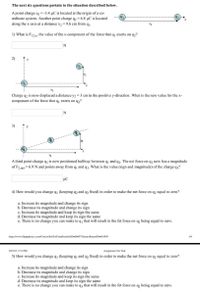Question
Please solve only part 3 in 10 minutes and then get thumbs up please

Transcribed Image Text:The next six questions pertain to the situation described below.
A point charge q --3.4 µC is located at the origin of a co-
ordinate system. Another point charge q2 = 6.8 µC is located
along the x-axis at a distance x, = 9.6 cm from qı.
92
1) What is F12 x, the value of the x-component of the force that q, exerts on q,?
2)
(9)
(9)
Charge q2 is now displaced a distance y2 =3 cm in the positive y-direction. What is the new value for the x-
component of the force that q exerts on q2?
3)
A third point charge q3 is now positioned halfway between q and q2. The net force on q2 now has a magnitude
91
of F2 net = 6.9 Nand points away from q and q3. What is the value (sign and magnitude) of the charge q3?
4) How would you change q1 (keeping q2 and q3 fixed) in order to make the net force on q2 equal to zero?
a. Increase its magnitude and change its sign
b. Decrease its magnitude and change its sign
c. Increase its magnitude and keep its sign the same
d. Decrease its magnitude and keep its sign the same
e. There is no change you can make to q, that will result in the fet force on q, being equal to zero.
https://www.flipitphysics.com/Course/SetTool?unitltemSetlD=606973&enrollmentID=461995
1/4
2/27/22, 7:51 PM
Assignment Set Tool
5) How would you change q3 (keeping q and q2 fixed) in order to make the net force on q2 equal to zero?
a. Increase its magnitude and change its sign
b. Decrease its magnitude and change its sign
c. Increase its magnitude and keep its sign the same
d. Decrease its magnitude and keep its sign the same
e. There is no change you can make to q3 that will result in the fet force on q, being equal to zero.
Expert Solution
This question has been solved!
Explore an expertly crafted, step-by-step solution for a thorough understanding of key concepts.
This is a popular solution
Trending nowThis is a popular solution!
Step by stepSolved in 2 steps with 2 images

Knowledge Booster
Similar questions
- A commuter airplane starts from an airport and takes the route shown in the figure below. The plane first flies to city A, located 175 km away in a direction 30.0° north of east. Next, it flies for 150 km 20.0° west of north, to city B. Finally, the plane flies 190 km due west, to city C. Find the location of city C relative to the location of the starting point. Looking for: distance in km, angle in degrees west of north.arrow_forwardhow do i solve this problemarrow_forwardM. 00 F. %24 D. %23 HP TrueVision HD Pavi Se th Site w Technical A AN Careers Mail - boss Texas Work MOe Homework A College X C O 8 https://www.webassign.net/web/Student/Assignment-Responses/last?dep3D28680740 不。 CTN LIAL The International Space Station has a mass of 4.19 x 105 kg and orbits at a radius of 6.79 x 106 m from the center of Earth. Find the gravitational force exerted by Earth on the space station, the space station's gravitational potential energy, and the weight of a 71.4 kg astronaut living inside the station. HINT (a) the gravitational force (in N) exerted by Earth on the space station (Enter the magnitude.) N (b) the space station's gravitational potential energy (in J) (c) the weight (in N) of an 71.4 kg astronaut living inside the station Need Help? Watch It Read It MY NOTES ASK YOUR TEACHER PREVIOUS ANSWERS SERCP11 7.5.P.039. 8. [2/2 Points] DETAILS dp AMIN g ong Pva ladurial A 732006020610 ADVANCED AUD insert Oly f5 114 米 $ ヤ % 6 #3 9. %3D K. pa B. 目arrow_forward
- Help with this homework question would be great, thanks!arrow_forwardPhysics Please help me with these physics homework questions. It will help me understand much betterarrow_forwardStudy Area Student Workbook Document Sharing User Settings An electron moves along the z-axis with v₂ = 2.6 × 107 m/s. As it passes the origin, what are the strength and direction of the magnetic field at the following (x, y, z) positions? Part A (1.0 cm, 0 cm, 0 cm) Express your answers in teslas separated by commas. ► View Available Hint(s) LIVE ΑΣΦ B₂, By, B₂ = Submit Part B (0 cm, 0 cm, 2.0 cm) Express your answers in teslas separated by commas. ► View Available Hint(s) B₂, By, B₂ = Submit IVE ΑΣΦ ? ? T T + 8arrow_forward
- A jet plane travels towards a ground-based radar dish. Radar locates the jet plane at a distance D = 11 km from the dish, at an angle θ = 46° above horizontal. 1.) What is the jet plane’s horizontal distance, DH in meters, from the radar dish? 2.)What is the jet plane's vertical distance, DV in meters, above the radar dish? 3.)Write an expression for the distance vector, D, in rectangular form in terms of D and θ, in a coordinate system with the dish at the origin and the unit vectors i and j in the horizontal and vertical directions. (to the right and up)arrow_forwardPlease solve both parts. They are both based on the information in question 25, so please solve 25 and 26. Thank you!!arrow_forward
arrow_back_ios
arrow_forward_ios